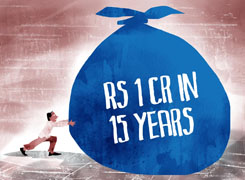Ramalingam Kalirajan |10893 Answers |Ask -Follow
Mutual Funds, Financial Planning Expert - Answered on May 26, 2024
He has an MBA in finance from the University of Madras and is a certified financial planner.
He is the director and chief financial planner at Holistic Investment, a Chennai-based firm that offers financial planning and wealth management advice.... more

I worked in Private company 1991 till 2007 after I stop working in india, since 2007 after me working in Abroad how much should I expect my pension amount after my age 55 as my Basic salary and D.A.that last period is as Basic 8510 and D.A 6051 .Pls can I know how much could I receive pension. At present date my age 53 now. Thanks
Understanding Your Financial Journey
First, it's commendable that you are planning for your retirement. Knowing the specifics of your employment history helps in estimating your pension accurately. You worked in a private company in India from 1991 to 2007 and have been working abroad since then. Your last drawn basic salary was Rs. 8,510 and Dearness Allowance (D.A.) was Rs. 6,051.
Basics of Employee Pension Scheme (EPS)
Eligibility:
Service Period: Minimum of 10 years of service is required to be eligible for the pension.
Age: Pension starts at the age of 58, but you can opt for early pension at 55 with a reduced amount.
Pensionable Salary:
It is the average salary of the last 60 months before exiting the EPS scheme.
For simplicity, let’s assume your last drawn basic + D.A. as the pensionable salary, which is Rs. 14,561 (8510 + 6051).
Pensionable Service:
Your service period is from 1991 to 2007, which is 16 years.
Early Pension Reduction
If you opt for early pension at 55, there is a reduction of 4% per year before 58. So, if you start at 55, it’s a reduction of 12% in total.
Calculating Your Pension
Without Reduction (at age 58):
Monthly Pension =(14561×16 / 70)=Rs. 3,327
With Early Pension Reduction (at age 55):
12% reduction for starting 3 years early:
Reduced Pension=3327×0.88=Rs. 2,928
Factors to Consider
Inflation: The calculated amount may seem small due to inflation over the years.
Additional Savings: Consider building a supplementary retirement corpus through other investment avenues.
Current Employment: Check if your current employment abroad provides any pension benefits or savings plans.
Recommendations for Financial Security
Mutual Funds:
Equity Mutual Funds: Invest in equity mutual funds for long-term growth to supplement your pension.
Debt Funds: These provide stability and reduce overall portfolio risk.
Systematic Investment Plan (SIP):
Discipline: Start a SIP to ensure disciplined investing.
Diversification: Allocate investments across different mutual fund categories for risk mitigation.
Reassess LIC Policy:
Surrender: Consider surrendering any traditional LIC policies and reinvesting in higher-return mutual funds.
Term Insurance: Opt for term insurance for adequate life cover at a lower premium.
Emergency Fund:
Essential: Set aside 6-12 months’ worth of expenses in a liquid fund for emergencies.
Regular Review:
Monitor Investments: Periodically review and adjust your portfolio based on market conditions and personal circumstances.
Seek Professional Advice: Consult a Certified Financial Planner (CFP) to optimise your investment strategy.
Conclusion
With your pensionable service and the pension formula, your estimated pension amount at age 55 is approximately Rs. 2,928 per month. This amount is relatively modest, so it’s crucial to supplement it with additional savings and investments. By investing in mutual funds through SIPs, maintaining an emergency fund, and considering term insurance, you can build a secure financial future.
Best Regards,
K. Ramalingam, MBA, CFP,
Chief Financial Planner,
www.holisticinvestment.in
You may like to see similar questions and answers below
Ramalingam Kalirajan |10893 Answers |Ask -Follow
Mutual Funds, Financial Planning Expert - Answered on Apr 30, 2024
Ramalingam Kalirajan |10893 Answers |Ask -Follow
Mutual Funds, Financial Planning Expert - Answered on Apr 29, 2024
Ramalingam Kalirajan |10893 Answers |Ask -Follow
Mutual Funds, Financial Planning Expert - Answered on May 26, 2024
Ramalingam Kalirajan |10893 Answers |Ask -Follow
Mutual Funds, Financial Planning Expert - Answered on Aug 16, 2024
Ramalingam Kalirajan |10893 Answers |Ask -Follow
Mutual Funds, Financial Planning Expert - Answered on Dec 15, 2025
Ramalingam Kalirajan |10893 Answers |Ask -Follow
Mutual Funds, Financial Planning Expert - Answered on Dec 15, 2025
Radheshyam Zanwar |6746 Answers |Ask -Follow
MHT-CET, IIT-JEE, NEET-UG Expert - Answered on Dec 15, 2025
Ramalingam Kalirajan |10893 Answers |Ask -Follow
Mutual Funds, Financial Planning Expert - Answered on Dec 15, 2025
Ramalingam Kalirajan |10893 Answers |Ask -Follow
Mutual Funds, Financial Planning Expert - Answered on Dec 15, 2025
Ramalingam Kalirajan |10893 Answers |Ask -Follow
Mutual Funds, Financial Planning Expert - Answered on Dec 15, 2025
Samraat Jadhav |2508 Answers |Ask -Follow
Stock Market Expert - Answered on Dec 15, 2025
Ramalingam Kalirajan |10893 Answers |Ask -Follow
Mutual Funds, Financial Planning Expert - Answered on Dec 15, 2025
Reetika Sharma |425 Answers |Ask -Follow
Financial Planner, MF and Insurance Expert - Answered on Dec 15, 2025
Radheshyam Zanwar |6746 Answers |Ask -Follow
MHT-CET, IIT-JEE, NEET-UG Expert - Answered on Dec 15, 2025























